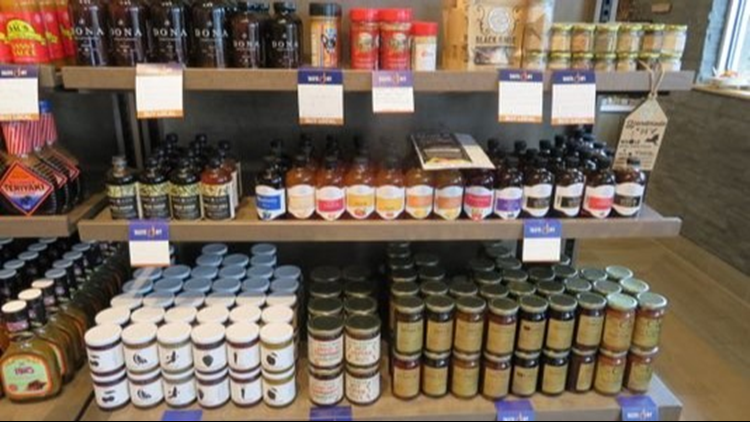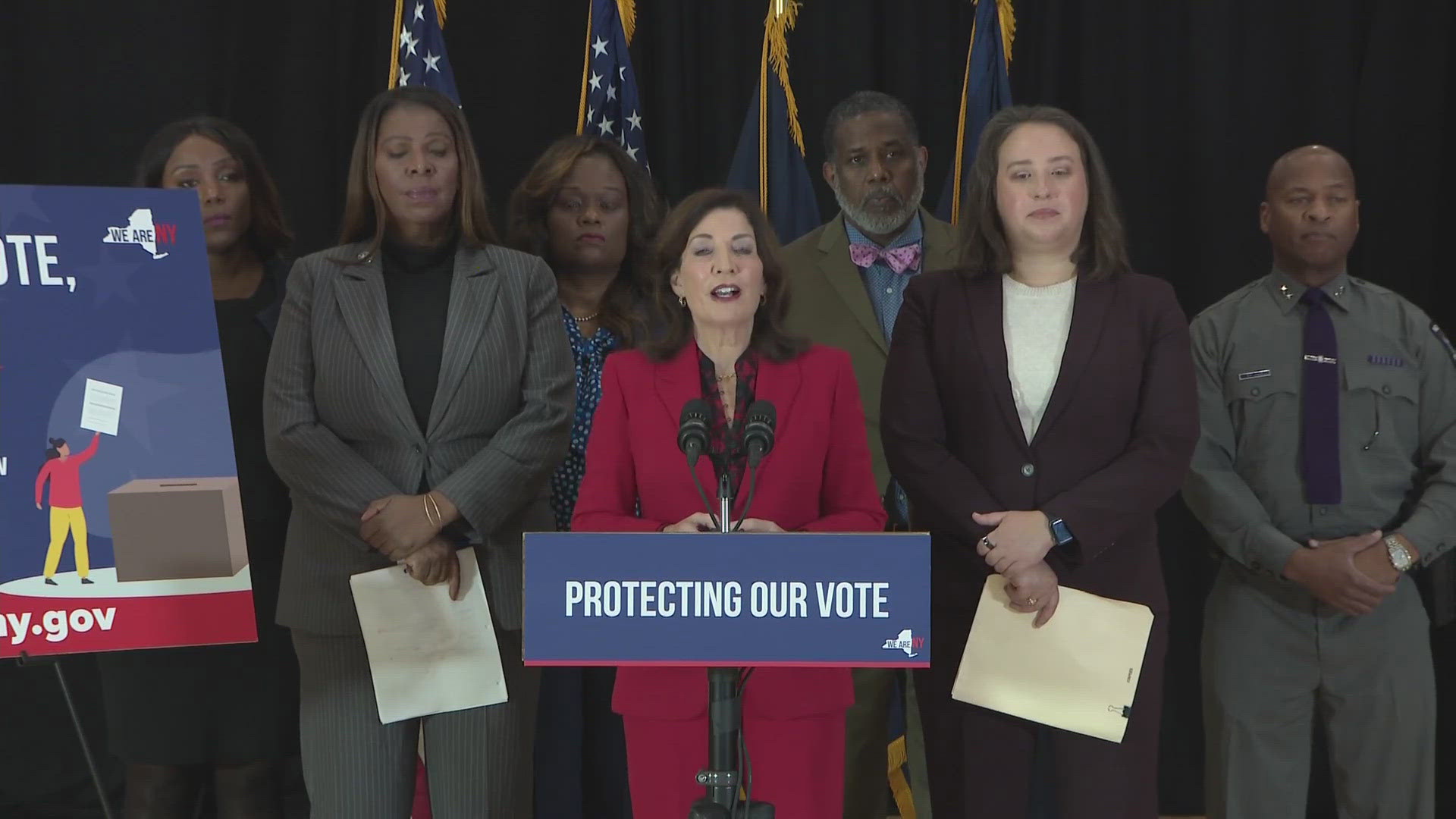After a long car ride from North Carolina, Martha and Michael Mancini were ready for a short respite.
They pulled into the Interstate 81 Southern Tier Welcome Center a few miles north of the Pennsylvania border only to discover a virtual marketplace inside — Spiedie sauce, pasta sauce, honey, goat milk moisturizer, Cornell Dairy ice cream, all among shelves packed with New York-produced goods.
Welcome to the Taste NY store, one of 66 across the state designed to promote and sell goods produced in New York state.
"We stopped because we were hungry," said Michael Mancini, a semi-retired jewelry and antique dealer from the Mohawk Valley community of St. Johnsville. He and his wife, Martha, each bought a $6.95 turkey and cheese on white prepared by Cline's Catering, of Binghamton, completing the sale at an automated checkout.
"The stuff is fresh," Mancini said.
Despite the several travelers cycling through the modern restrooms on a recent Tuesday afternoon, the Mancinis were dining alone at the self-service shop.
"I just told my wife, 'How do they do with all these products?'" said Michael Mancini, no stranger to the retail marketplace, having operated a jewelry store in San Juan, Puerto Rico, for 20 years. "It's not cheap. And I don't know if the volume is there."
There's no telling how the Taste NY stores that stretch across the state from Grand Island to Long Island perform — if they make a profit or operate at a loss.
Since it was first asked for a full accounting in mid-February, New York's Department of Agriculture & Markets, which is responsible for the stores, has been unable to produce collective or individual performance data on the stores from either 2016 or 2017.
New York’s agriculture department has spent millions in recent years building its Taste NY concept. The state department apparently is unable to deliver financial records of how these outlets perform, how much is sold and what profits — if any — are made on those sales.
A Freedom of Information Law request from the Press & Sun-Bulletin / pressconnects.com has gone unfulfilled — delayed eight separate times. The request has left the department head-scratching about what numbers it actually has available.
The lack of a response raises questions about how closely the stores are monitored, and whether poor-performing outlets are subject to financial scrutiny to determine whether a different merchandising strategy would enhance sales or if the store needs to be re-evaluated and closed.
Nevertheless, state representatives say the stores are an "undeniable success."
But whether they can actually measure success is questionable if the state cannot assess the sales against the cost of the operation, a critical measure in gauging whether the stores collectively and individually perform up to standards.
When confronted about the delay following a recent forestry products summit in the Town of Dickinson, Agriculture & Markets Commissioner Richard Ball said, "Let's get this thing done."
Yet still, no detailed financial records were supplied Only total sales volume for the 66 stores were emailed a week following the event. The response was barren of spreadsheets or even a basic income statement from the stores.
Ball, who operates his own Schoharie County farm stand known as "The Carrot Barn," acknowledged that he inspects monthly sales and profit reports from his own private enterprise. But he was largely unaware of the same details from the state-operated stores.
"The profit and loss reports are going to very important in assessing how the business is doing and how a product is selling," said Brandon Szerwo, assistant professor of accounting and law in the University at Buffalo School of Management.
"If you have multiple locations, a profit and loss statement is going to be important in telling you what is selling and what isn't selling," he said.
The reports are critical to determining the overall health of the enterprise, how effective managers are in operating individual stores, and the success of merchandising strategy, said the professor, whose research interests include understanding financial reporting quality. A review of those monthly reports are critical for the efficient operation of a retail enterprise.
"Those (profit and loss statements) will be helpful in determining the health of the business and the health of the individual store," Szerwo said.
State officials are not entirely blind to the operation. They have a grasp of total sales. Gov. Andrew Cuomo announced earlier this year the stores grossed $16 million in revenue in 2017, up $3 million from the previous year. And they have said sales in 2014 were $1.5 million, and $4.5 million in 2015.
But they are unable to provide any other detail on the operation, such as cost of goods sold, employee wages and other overhead costs. So, while New Yorkers may know total sales at the 66 outlets, they don't know how much those sales are costing the state.
"We're taxpayers, we ought to know," said Martha Mancini, when told Freedom of Information requests for the profit and loss statements for the individual and collective operations dating back to 2016 were still being collected eight months after the initial request.
"It's not supposed to be secret," Martha Mancini said.
Agriculture and Markets was able to pull individual sales data for its glossy 2017 annual report for at least one store: "The Taste NY Market at Grand Central Terminal, first opened in October 2014, grossed more than $1 million for the third year in a row," the report says.
Don't begin to ask about the cost of building the stores. Those outlays are shared by multiple agencies, according to Agriculture & Markets. While the store may be operated by Ball's agency, the cost of building those stores are often hidden within the Department of Transportation budgets, or outlays by Cooperative Extension Services, and the state Office of Parks, Recreation and Historic Preservation. So it is difficult to determine the total expense of building the shops.
While Taste NY's primary purpose is to promote goods produced in the state, it's difficult to tell how much that promotion is costing the taxpayers and if the state is getting a return on its investment.
"The Taste NY initiative was launched in 2013 with the goal to create a program that would expand marketing opportunities for New York farms and businesses participating in the program and help these businesses reach new markets and consumers," said Jola Szubielski, director of public information for the state department of Agriculture & Markets.
Two Taste of NY stores were subject to disputes between the state and the U.S. Department of Transportation. The federal agency forced stores in Long Island and Kirkwood to switch to self-checkout kiosks in a bid to avoid federal highway funding cuts.
The Federal Highway Administration contended the two stores had been operating in violation of federal law, which bans nearly all over-the-counter sales at rest areas opened after 1960 on interstate highways.
The law was meant to get drivers off the highways, and into local towns and cities to spend at restaurants and stores.
As part of the negotiations, federal regulators agreed to allow the switch from over-the-counter sales to a self-checkout system on two conditions: The state made the change by March 2017 and did not expand the system to any other rest areas on Interstate highways.
The Taste NY store in Broome County opened in July 2015 on I-81 near the Pennsylvania border in Kirkwood. The $20 million Long Island welcome center opened in 2016.



